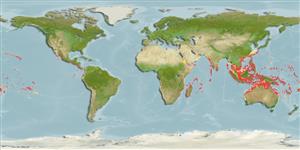Actinopterígios (peces con aletas radiadas) >
Tetraodontiformes (Puffers and filefishes) >
Diodontidae (Porcupinefishes (burrfishes))
Etymology: Diodon: Greek, di = two + Greek, odous = teeth (Ref. 45335). More on author: Shaw.
Medioambiente / Clima / Gama
Ecología
; marino asociado a arrecife; rango de profundidad 1 - 90 m (Ref. 37816), usually 15 - 30 m (Ref. 9680). Tropical, preferred ?; 30°N - 30°S
Indo-Pacific: East Africa to the Society Islands, north to southern Japan, south to New South Wales. Not present in Hawaii (Ref. 9680). Southeast Atlantic: southeast coast of South Africa (Ref. 4423).
Tamaño / Peso / Age
Maturity: Lm ? range ? - ? cm
Max length : 65.0 cm TL macho / no sexado; (Ref. 9710)
Espinas dorsales (total): 0; Radios blandos dorsales (total): 14-16; Espinas anales 0; Radios blandos anales: 14 - 16. Spines short (Ref. 1602). Several yellow-edged dark blotches on body (Ref. 559). D. liturosus differs from D. hystrix by its shorter spines and color (Ref. 37816).
Inhabits reef edges and slopes (Ref. 6113, 48637). Hides in caves and ledges during the day and forages at night (Ref. 9680). Also found below plate-corals during the day and often deep, ranging to at least 40 meters depth. Juveniles occur in lagoons and estuaries (Ref. 48637). Solitary. Feeds on crustaceans and mollusks. Not usually marketed (Ref. 9680).
Life cycle and mating behavior
Madurez | Reproducción | Puesta | Huevos | Fecundidad | Larva
Myers, R.F., 1991. Micronesian reef fishes. Second Ed. Coral Graphics, Barrigada, Guam. 298 p. (Ref. 1602)
IUCN Red List Status (Ref. 115185)
CITES (Ref. 94142)
Not Evaluated
Threat to humans
Reports of ciguatera poisoning (Ref. 30303)
Human uses
Pesquerías: escaso valor comercial; Acuario: Comercial
Más información
ReferenciasAcuiculturaPerfil de acuiculturaRazasGenéticaFrecuencias de alelosheritabilidadEnfermedadesProcesamientoMass conversion
Herramientas
Special reports
Download XML
Fuentes de Internet
